As Episode 8 of the Star Wars saga hits cinemas and adds a new chapter in the mythology of the galaxy far, far away, here’s a timely revisit to all the existing films in the epic, magical universe Uncle George made.
Even die-hard fans have mixed feelings about the various films, particularly in regard to the prequel trilogy, which has been excessively and mostly unfairly maligned. But here is a loving and critical look back across cinema’s greatest saga, with the added power of hindsight and greater perspective.
I’m a Star Wars nut, so I personally have never yet seen a Star Wars movie I didn’t like on some level or another (except the Holiday Special – which I cannot erase from my memory no matter how hard I try), though of course they are not all equal. But twelve years now after George Lucas wrapped his epic, six-film saga – and over four years since Lucasfilm was handed over to the Disney corporation – how do each of the films hold up, both on their own and in relation to each other?
Where The Last Jedi will fit into this tapestry and how it will impact everything that has gone before it – we await to see. But, as someone who has been steeped in Star Wars love since the age of about six, here is a thoughtful, considered re-appraisal of everything that has come so far, how it all inter-relates and how well it all holds up.
–
A NEW HOPE (1977)

The Good: Superb casting; lovable, endearing characters and character dynamics; necessary gravitas provided by Alec Guinness and Peter Cushing; groundbreaking technical accomplishments and special effects; endless wit and charisma; wonderful, early world-building on Tatooine with Jawas, Tusken Raiders, moisture vaporators, etc.
The Not So Good: Some cheesy dialogue and slightly off delivery; a much less interesting or menacing Darth Vader than in Empire Strikes Back; a painfully slow and stilted lightsaber duel between Vader and Kenobi.
Best Moments: Carrie Fisher’s iconic introduction moment as Princess Leia; Luke’s first encounter with the elderly Obi-Wan Kenobi; the Mos Eisley Cantina; the iconic Tatooine sunset scene; our first sight of all those X-Wings and Tie-Fighters.
Where it all began. I didn’t actually see this first Star Wars movie until after I’d already seen Empire and Jedi as a six or seven-year-old, so my primary nostalgia was always more for the two sequels than for this original.
Either way, however, there’s nothing you can say about A New Hope other than to affirm its singular status as a cinematic game-changer and as the ultimate standalone sci-fi fantasy adventure. Modelled largely on the ‘hero’s journey’ motif of Lucas’s friend Joseph Campbell and firmly rooted in the old Flash Gordon-style Saturday morning matinees of Lucas’s youth, this is the easiest, least complicated and most accessible of the films.
Aside from all the obvious things; the pioneering special-effects techniques, the extraordinary level of imagination, invention and design (Tie-Fighters, X-Wings, lightsabers, Stormtroopers, Wookies, Droids, etc), the brilliant action sequences, and the tremendously endearing characters, one major thing that imparted a great deal of gravitas to the movie that might’ve otherwise been missing was Lucas managing to get Alec Guinness on board as Obi-Wan Kenobi. The presence of such a major, veteran actor really makes a world of difference and Guinness’s gentle, wise Kenobi serves as a perfect counter-balance to all the Jawas, droids, Cantina bands and Death Stars.

Regardless of its stature as the film that reinvented cinema, A New Hope remains at its core a classic story of a bored, listless ‘nobody’ (who turns out to be not a ‘nobody’ at all) going off on a great adventure and undertaking the ‘hero’s journey’. The simple image that would become so iconic – that of a wistful Luke gazing at the twin sunset of Tatooine and longing for adventure – very much embodies the soul of the movie and possibly of the entire saga.
Also, using the two droids – Artoo and Threepio – as the audience’s primary eyes and ears as we enter the universe was a masterful storytelling decision by Lucas. And every one of the casting choices was undeniably superb (I cannot for the life of me picture Jodie Foster as Leia or Kurt Russell as Han Solo).
In some ways, A New Hope, as contrasted to the prequel trilogy, somewhat demonstrates how necessity is mother of invention and how sometimes limited resources can yield more consistent results than unlimited capabilities. Unlike later on, where Lucas had unlimited resources and powers and somewhat floundered in places due to all his options, the limited options of A New Hope actually allowed for the creation of a more real-world, life-like environment and aesthetic. The banged-up, second-hand feel of this universe, from the Millennium Falcon and Luke’s landspeeder to the costumes and to the droids themselves, the ANH world is gritty and dusty, in great contrast to some of the occasionally excessive CG and inauthentic seeming environments of Attack of the Clones in particular.
It is also, to be honest, the only Star Wars film that now looks a little dated; but that only really adds to its enduring charm. If we remove the rose-tinted glasses for a moment and examine the movie honestly, we can see that there’s some cheesy dialogue, clunky delivery (even from Harrison Ford) and silly moments; but given the sheer nightmare Lucas and co faced trying to get this film made, not to mention the extent to which everyone involved was in unknown territory, those kinds of side-effects are perfectly understandable.
George Lucas was hospitalised and almost had a nervous breakdown trying to get this movie made, his path continuously impeded by those who had no faith in the project and no understanding of what Lucas was trying to do. It is scary to think how easily this film might have been scrapped altogether and never seen completion; in which case we also would never have had any of the sequels.
The enormous legions of post-Episode I George Lucas haters are not, in my estimation, Star Wars fans at all – there’s no way you *could* be a Star Wars fan and not feel a debt of gratitude to George Lucas or to the level of vision and commitment he had.
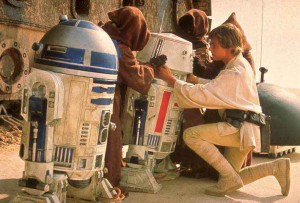
In light of the prequels, the jump (chronologically) from the kind of story and events we have in Revenge of the Sith to what we have in A New Hope is a little jarring. ROTS is so dramatic, so eventful and dense with climatic events, that when you move back to ANH it’s a little strange how quiet, uneventful and downbeat everything is. On the other hand, however, Lucas argues this is somewhat the point: we’ve just come from this vast setting, a busy Galactic Republic, a thriving Jedi Order, the Clone Wars, and all these epic, legendary events, and then we see that by the time of ANH everything is more dull and scaled down. We see this in Luke himself, who lives a bored, wistful life and gets excited at mention of the Clone Wars.
The dynamic is kind of reminiscent of how we think of the Dark Ages after the fall of the Roman Empire; there all these myths and stories of great wars and adventure and heroes and old Republics, but it’s in the past.
In that respect, the transition from ROTS to ANH actually works pretty well. Also, now that we’ve seen the younger Obi-Wan Kenobi in his prime and we’ve particularly seen the poignant moment of Luke and Leia being born in ROTS and Obi-Wan delivering the infant Luke to Lars and Beru on Tatooine, this whole early Tatooine part of ANH is all the more poignant and rich, because we really properly understand that Luke’s boredom with this desert life isn’t just a case of teenage restlessness and desire for adventure, but that it is hard-wired into his DNA and midi-chlorians.
There’s an added poignancy also now to the elderly Obi-Wan living out so many years in isolation and being a little disheveled when Luke finds him; the idea of him just pottering about a little hut in the desert for so many years seems much sadder now than it did originally.
The thing that now doesn’t work so well is the Darth Vader of ANH, who is a little clunky and under-developed. To go from the fire and brimstone of ROTS, Anakin’s fall and the birth of Vader to this kind of petty henchman of Tarkin’s that we see in ANH is a little inconsistent. In Vader terms, it almost works better to go from ROTS straight to ESB. But in general the transition from ROTS to ANH kind of does work, mostly for the reasons highlighted above.
Also, the addition of Rogue One into the mix adds tremendously to A New Hope. The first Star Wars standalone film, released last year, actually has a transformative effect on ANH, as I discovered vividly when I recently rewatched ANH for its fortieth anniversary.
As I noted then, A New Hope is a film that is contiually growing, evolving, morphing over many years, due to the effects of the other films.
THE EMPIRE STRIKES BACK (1980)
–
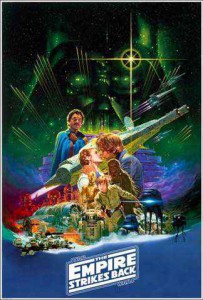
The Good: Absolutely perfect script; wonderful character dynamics; breathtaking, beautifully choregraphed sequences; Dagobah and Yoda; massive character development for everyone; utterly absorbing finale/cliffhanger; Cloud City; John William’s masterful soundtrack; that Vader/Luke duel; pretty much the whole damn thing.
The Not So Good: No, nothing. Seriously, nothing. All good.
Best Moments: Yoda’s playful introduction; the asteroid field; Luke versus Vader; Leia’s race to save Han; the Carbonite scene.
Regarded by most people as the best of the Star Wars movies. While with an objective, cold reading this is probably true, I tend to regard Return of the Jedi as my personal favorite (with Revenge of the Sith ).
But Empire is the most immaculate and perfect of the films if we’re going to be empirical and non-subjective, a massive step up from the original film, with Lawrence Kasdan playing a big part in the key creative process. All of the clunkiness and off-kilter delivery of A New Hope is entirely fixed by now and everyone is at their very best.
The effects sequences, from the AT-AT Hoth Battle to the Millennium Falcon outwitting and out-manuevering Star Destroyers and Tie-Fighters, are utterly jaw-dropping (remember, this was 1980, for crying out loud). The character dynamics are incredibly effective and endearing right across the board. There is memorable moment after memorable moment, all punctuated with humour, fascination, excitement and emotion all in perfect measure.
This is Han Solo’s best film in the trilogy and probably Leia’s too; while Chewbacca is adorable, Artoo and Threepio are absolute gold throughout, Luke’s training is fascinating, and Darth Vader is a gazillion times more bad-ass and fascinating than in the first movie. As if all that isn’t enough, this film introduces both Yoda and Lando Calrissian and makes us fall in love with both of them instantly.
Yoda’s introduction is utterly beguiling every time, surely one of the greatest intro scenes in cinema. Lando is the most suave and charismatic character in the entire franchise. Cloud City is utterly breathtaking. And oh my god, I almost forgot Boba Fett and the bounty hunters. The breathtaking Cloud City meanwhile has Lucas fulfilling his desire of bringing to life the kind of exotic, awe-inspiring setting that he wasn’t able to in A New Hope; a desire that would find more comprehensive and gorgeous expression many years later in the epic, magnificent settings of The Phantom Menace.
Everything builds to the first confrontation between Luke and Vader, which remains forever fascinating. The “I am your father” revelation no longer packs the punch it did when we were kids, for obvious reasons; but the entire sequence is still utterly beguiling, epic and cinematically brilliant. The grim, sad ending looks pretty tame now that we’ve seen Revenge of the Sith (try that for dark and despairing), but when I was a kid this ending slayed me. Luke losing his arm, Vader being his Dad, Han Solo being frozen in Carbonite (what an image), Leia’s despair; it was all too much.
I swear Carrie Fisher could express more in a single close-up shot of her face than Natalie Portman could in the entire prequel trilogy.
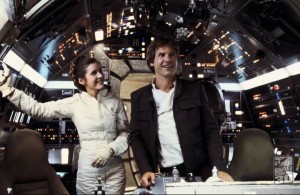
In the final act, Kasdan and co manage to evoke poignancy and emotion in even the smallest of elements, such as a forlorn Chewbacca trying to re-assemble a dismembered Threepio (which is incredibly poignant – and yet it’s a droid and guy in a bear suit) or such as the beautiful Force-connection moment between Leia and Luke as he is hanging on for dear life off Cloud City (now poignantly echoed or foreshadowed by the Anakin/Padme Force connection scene in ROTS). Watching Leia’s reaction to Han’s freezing in the Carbonite was heartbreaking to me as a six-year-old, as was Chewbacca’s animal-like anguish.
The Empire Strikes Back really is perfect; it is a cinematic masterclass.
In light of the prequels, there are of course lots of interesting elements. The Yoda of ESB, as contrasted to the Yoda of the prequels, is all the more curious to observe. Many fans feel the prequels ruined Yoda somewhat. However, it’s interesting to note that difference in Yoda here and I don’t just mean his puppet-based nature. Yoda almost seems a little senile, a little more barmy when Luke finds him. Certainly more playful and odd-mannered; this might simply be an effect of his prolonged isolation.
He has simply been alone in that swamp for so long that the lack of interaction has seriously effected his personality, which is fascinating.
Vader’s attempted corruption of Luke on Bespin is now foreshadowed by his climatic confrontation with Padme in ROTS; just as he tells Padme “together we can rule the galaxy”, he now makes the same offer to Luke, and Luke we can see has more of his mother in him than his father.
Not that Empire *needed* any new life breathed into it, but these new connections and echoes are nevertheless interesting, giving us new dimensions to a film we already knew like the backs of our hands.
RETURN of the JEDI (1983)
–

The Good: A great return to Tatooine and the fun and absurdities of Jabba’s Palace; the darker, more grown-up Luke Skywalker; rich themes and resonances; the epic, emotion-laden Luke/Vader/Sidious finale to the Skywalker saga.
The Not So Good: Boba Fett dying by falling into a giant vagina in the desert; an Ewok being able to operate a speeder-bike.
Best Moments: The entire Palpatine, Luke, Vader sequence; Luke’s final assault on Vader; Anakin’s redemption; Yoda’s deathbed; the Death Star Battle; the speeder-bike chase in the forest; the end celebration on Endor; Luke’s bad-ass arrival in Jabba’s Palace.
A film that is bafflingly maligned by many people, even Star Wars fans. Sure, there are probably a couple of misfires here, but it’s difficult for me to find much in Return of the Jedi that bothers me. Of the three original movies, this is probably the one I have the most nostalgia for and the most emotional sense of connection.
This film is of course the climax; originally to the first trilogy, but now also to the broader six-film saga too. In that latter sense – as a climax to the prequel trilogy and not just the originals – ROTJ works even more powerfully than it did originally.
Jabba’s Palace? Brilliant, all of it. As a kid, and even now, I adored all of that; Bib Fortuna, the various aliens and creatures, the perpetual coolness of Boba Fett, the Rancor, even Sy Snootles and the band. Our heroes all arriving on the scene one by one, in stages, was also always a great way to build the story, with Lando in disguise, Leia arriving as the alien bounty hunter ‘Boussh’, and the droids arriving first, all parts of a thought-out plan.
Finally Luke arriving is one of my favorite moments in the entire franchise. Our fascination over Luke after his utter devastation in Empire Strikes Back (somewhat comparable to our fascination and curiosity *now* in regard what Luke will be like in Episode 8) had us wondering what state he would be in now. Luke’s arrival at Jabba’s Palace is at the heart of what is so great about ROTJ; it’s the return of the hero, the ‘return of the jedi’ literally, more powerful and more Jedi than ever, and also darker, more moody and brooding.

While ESB was a marvellous showcase for all the characters and actors, all of them at their very best, ROTJ is more squarely about Luke as the central hero.
This is the culmination of the Luke story and also of the Skywalker saga in general. What remains eternally fascinating about the Luke of ROTJ is that he is dark. He is angry and has been lied to by the people he has trusted and is trying to come to terms with the truth of his heritage. It’s in this condition that he goes into his confrontation with Vader and the Emperor. Those scenes, where Palpatine tries to seduce Luke, culminating finally in Luke’s final assault on his father, are utterly, utterly compelling. Palpatine’s pure, unadulterated evil, Vader’s uncertainty and faltering, Luke’s grimness and the sense of how close he comes to turning to the Dark Side; it’s all endlessly compelling and fascinating.
Anyone who dismisses ROTJ as ‘the bad one’ is clearly not someone who gets Star Wars or is really a Star Wars fan.
This dark, gothic finale is the most important sequence in the entire trilogy; and it is full of emotion and tension. That moment that finally unleashes all his rage against Vader, accompanied by that dark choral swell of John Williams music that cuts into your very soul, is probably the most powerful dramatic moment in Star Wars (I, in fact, wrote an article on my other blog a few years ago, detailing what I thought then were the 20 Greatest Moments in Star Wars – and I put this moment at No.1).
This is the Luke Skywalker I fell in love with; the Luke who is dark, suffering and close to the edge, but who ultimately resists the Emperor, redeems Anakin and helps end the Sith.
As I mentioned before, the prequel trilogy – particularly Revenge of the Sith – has also breathed even more new life into ROTJ, the plight of Luke and the end showdown with Vader and Emperor. Those two films, ROTJ and ROTS, now resonate with each other so strongly that you can’t watch one without thinking about the other. The importance of the ROTJ/ROTS connection is so interesting it could probably warrant a whole separate essay – though I did touch on it quite a bit in this older piece about Revenge of the Sith.
And that’s just one element of the film; I haven’t even mentioned the mind-blowing attack on the Death Star – a space-battle sequence that still just looks utterly extraordinary even now (and this was 1982, for god’s sake), culminating in that edge-of-the-seat final run on the Death Star, with the Falcon escaping just in the nick of time (something I’ve seen recreated or reference in about two-dozen other films since).
Meanwhile, the death of Yoda and that whole sequence on Dagobah with Yoda and later the ghost of Kenobi are endlessly fascinating, again even more so post-ROTS than at the time. And that ending, in general, is – I still maintain – the perfect ending for the saga and the best possible end-point for the Star Wars mythology.
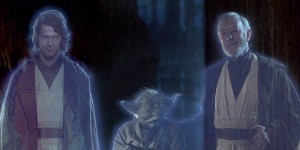
In essence, I’m still saying Return of the Jedi works supremely as the chronological end-point to the Star Wars saga – without The Force Awakens necessarily coming along to change that dynamic.
Also, in terms of the broader saga, the dynamics in ROTJ are the most interesting. The insistence of Yoda and Obi-Wan that Vader must be killed is based in their bitterness and experience of what happened in ROTS; but Luke, who didn’t experience any of that, is more in tune with the feelings of his deceased mother and her dying conviction that “there is still good in him”.
Also, having now seen ROTS, the dynamics of the Palpatine, Vader, Luke showdown are all the more interesting, partly mirrored in the Anakin/Dooku/Palpatine scene from ROTS and even more so in Anakin’s siding with Palpatine against Mace Windu. When we see Vader finally intervening to save Luke from the Emperor now, we’re no longer just seeing it as Anakin saving his son, but as Anakin finally putting the right the wrong decision he’d made all those years ago when he’d allowed the Emperor to kill Windu – the very moment that had marked Anakin’s final turn to the Dark Side.
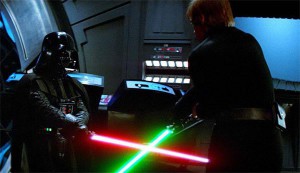
Now, here on the Death Star, he has seen his son show all the strength and Jedi nobility that he himself had failed to in the past, as Luke withstands Palpatine’s seduction and remains true to the Jedi ideals. In his own son’s actions he finally sees the Jedi he himself should’ve been in the past, and now at the last minute he redeems himself.
It’s epic, it’s so resonant and poignant, and it’s the perfect, fitting ending for Anakin Skywalker and his son.
Anyone who dismisses ROTJ doesn’t know what they’re talking about. And by the way, I loved the Ewoks and feel absolutely no embarrassment in admitting to that; always did and always will. The scene of Threepio telling the Star Wars story to the Ewoks is one of the sweetest moments in this film and in any Star Wars movie.
And, I’m sorry, but – no matter how much I liked The Force Awakens or might enjoy subsequent Star Wars films – I will always maintain that Return of the Jedi is never going to be bettered as the perfect and most fitting end-point for the story.
Read more: ‘Why RETURN OF THE JEDI Will Remain the Only Fitting End-Point for the Star Wars Saga’…
THE PHANTOM MENACE (1999)

The Good: Breathtaking worlds and environments throughout the movie; an extraordinarily high level of conceptual design, wardrobe, and general aesthetics; great intrigue and manuevering with Palpatine/Sideous and the beginning of the downfall of the Republic; Liam Neeson as Qui-Gon Jinn; some astonishing sequences and cinematic accomplishments.
The Not So Good: Probably too much Jar Jar Binks; the Gungans in general; the weirdly Chinese Neimodians; some really bad scripting and equally bad delivery; the badly misjudged Gungans vs Droids finale.
Best Moments: The spectacular Podrace sequence; the sheer majesty of the three-way Duel of the Fates; the discovery of Anakin Skywalker.
One of the most unfairly maligned and widely hated movies of all time, The Phantom Menace is nowhere near as bad as all the anti-Lucas, popcorn munching armchair critics try to make out. Yes, Jar Jar was overdone. Yes, the Gungans aren’t very endearing and neither are the weirdly Chinese-accented Neimodians. And yes, there is some bad scripting and very bad delivery in places. Lucas made major mistakes and misjudgements, no doubt.
And yes, we were disappointed back in 1999 because we were basically an entire generation of people preparing for the Second Coming. And for some of us, the film we actually got was equivalent to what would happen if a crowd of fundamentalist Christians gathered for the Biblical Second Coming suddenly discovered that Jesus is actually Jar Jar; “Mesa back! Mesa come to take yousa up ta Heaven now, okey-day?”
Yet for all that, there is so much good in Episode I. The level of sheer artistry in conceptual designs, costume design, interiors, effects sequences, and frankly the entire production, is just extraordinary. The worlds and settings we get in Episode I are breathtaking works of extraordinary artistry, from the majestic, Roman/Renaissance city of Theed and the enchanting underwater city of Otoh Gunga to the marvellous metropolis of Coruscant and the familiar, dusty nostalgia of Tatooine and Mos Espa.
Although there’s lots of CG, there is still at this stage plenty of real-world on-location filming and real sets, still maintaining a sense of reality, particularly with the Tunisia shoots. Even the CG – Theed is almost entirely CG – is utterly convincing and absorbing, unlike in Episode II where the excessive CG starts to become jarring and unconvincing in places.

Darth Maul is awesome, the climatic three-way lightsaber duel is totally off-the-scale and the podrace is a piece of immaculately crafted cinematic genius. The film is visually – and in terms of cinematography – one of the most immaculate, stunning pieces of cinema ever produced.
It also adds immensely to the mythology of Star Wars, the Jedi and the Force. Add to that Liam Neeson’s solid, convincing embodiment of Qui-Gon Jinn, and all the little sweeteners like Artoo-Deetoo, the Battle Droids, and Watto (a CG triumph that should’ve really made Jar Jar unnecessary), and it’s easy to demonstrate that all the tedious Episode I bashing has outlived its usefulness and become hollow.
Lucas’s biggest mistake arguably was that he didn’t establish a consistent tone for the movie, which is very serious and plot-orientated in places, while silly and child-oriented in others and the effect of is very jarring. That being said, there’s a very clear reason *why* Lucas went for a very child-friendly tone with Episode I – because it’s a film centered on a child and seen therefore through a chuld’s perspective. It thematically makes perfect sense; moreover, Lucas knew he was going to a dark place by Episode III, which made it all the more meaningful to go for a tone of child-like innocence and naivety in Episode I.
What’s remarkable to me is that, even though I don’t at all consider it the best Star Wars movie, The Phantom Menace is always the one I get most enthusiastic about rewatching.
Read more: ‘From Podracing to Palpatine – 10 Genuinely Brilliant Things About THE PHANTOM MENACE’…
ATTACK of the CLONES (2002)
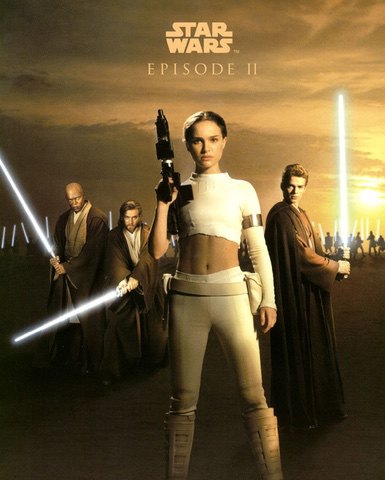
The Good: Lots of very cool Obi-Wan Kenobi/Ewan McGreggor; a cool mystery story/investigation; some intriguing backstory to the fall of the Republic and rise of the Empire; some terrific effects sequences.
The Not So Good: Excessive reliance on CGI; lack of authentic feeling environments; lots of stilted, awkward acting; some poorly done romance scenes; some very bad lines and delivery, particularly by Natalie Portman.
Best Moments: Obi-Wan’s awesome clash with Jango Fett on Kamino; the Slave I asteroid chase; Windu’s bad-ass arrival on Geonosis; Windu beheading Jango; the stunning Coruscant city chase sequence; Anakin’s slaughter of the Sand People; the Death of Shmi Skywalker.
The second instalment of the prequel trilogy is the most difficult to deal with. Not as overtly silly as Episode I was in places, instead Episode II’s weaknesses are of a different sort. This has some superb things in it, but it is undermined by niggling problems. The problems with bad scripting and some bad delivery are still there and it’s obvious that George didn’t give adequate enough direction to the actors in several instances. Natalie Portman turns in a very poor performance.
That being said, Hayden Christensen – although he is much, much better in Episode III, and is problematic in some of these scenes – gets way too much flack and not enough credit for the places where he excels (the “I killed them – every one of them” scene has Christensen delivering one of the best dramatic performances in the entire Star Wars saga). Bear in mind that he is *meant* to be playing an erratic, moody, awkward teenager here (a teenage monk, at that) – and so a lot of what people find ‘annoying’ about him is *meant* to be there.
As for the romance story – yes, some of it is very poorly acted and badly written. Bits of it are good though (the talk about dictatorship in the field is a highlight).
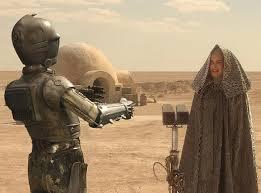
In actual fact, some of the scenes that were taken out of the final film should’ve been kept in and some of the scenes that were kept in should’ve been taken out.
I’ve realised a while ago that this film could’ve been substantially improved by simply doing a straight swap of a couple of scenes (take out some of the awkward Anakin/Padme stuff and put in the deleted scenes of Anakin meeting Padme’s family and visiting the house she grew up in; and put back in the scene of Padme explaining her upbringing and her political outlook , her work with refugees, etc).
The other major problem with this film is the over-reliance on excessive CGI. While there was CG in The Phantom Menace, it was better done and more believable, and was also coupled with real-life locations and real sets. In Episode II, on the other hand, some of it feels tangibly false and unconvincing. There is an unfortunate sterility to too many of the settings, as well as to some of the performances in key scenes.
Even simple scenes, like an early scene of Anakin and Obi-Wan with the Jedi Council, are so badly lit, so lacking in tone or rendering that you almost feel you’re watching a rough cut. Take that Anakin/Obi-Wan Jedi Council scene, which is so anaemic, so drab and colorless, and then compares it to the Jedi Council scenes from Episode I and there’s a world of difference.
In fairness to Lucas, Episode II in 2002 was a landmark film in the development of CGI and of digital filmmaking that we all take for granted now (it was the first film to ever be shot entirely digitally) – and so a lot of the problems are essentially teething problems. But what Lucas was doing back then essentially paved the way for most of the blockbuster films that now dominate cinema (whether that’s a good or bad thing depends on your personal tastes).

Most of these problems were fully fixed for Episode III; but it leaves Episode II feeling like an awkward, deficient entity for the most part, also undermined by lapses in logic, emotional immaturity, and by the unbelievability of several scenes.
However, having said all of that, there are some genuinely brilliant things in Attack of the Clones. The political intrigue and Palpatine’s scheming is still interesting, even if a little less so than in Episode I.
But more importantly, this is a great Obi-Wan Kenobi movie. I totally love watching Obi-Wan Kenobi going off an adventure mystery, investigating like an intergalactic Jedi Columbo and uncovering plots. Ewan McGreggor is the most convincing thing in this film, similar to how Liam Neeson was in Episode I. Kenobi flying about in his Jedi Starfighter is a classic piece of Star Wars. The Obi-Wan/Jango fight on Kamino is brilliant and feels like a missing sequence from The Original Trilogy, while the asteroid field chase is fabulous stuff.
Count Dooku is an interesting addition to the mix, aided by Christopher Lee’s sheer presence, and the beginning of the Clone Wars is suitably intriguing, with some very good plotting (although also some pretty troubling plot problems).
Episode II is an awkward, difficult movie. But it has brilliant things in it. And, for whatever gripes you could level at it, I still thoroughly, thorougly enjoy it every time I come back to it (which is about once a year). Indeed, I am continously seeing new things in it – new angles, new connections, new subtexts, new nuances – every time I watch it.
It is a film that reveals itself and more and more very time you examine it, so that it feels like it is constantly growing. It is also the most intriguing and mysterious of the films, being essentially a film about a giant conspiracy that – even by the film’s end – no one in the story has clocked onto or understood.
And most of what was wrong with this film was remedied in Episode III.
REVENGE OF THE SITH (2005)

The Good: Much tighter storytelling; fluid, flowing screenplay; more brilliant, memorable moments or images than I can count; extraordinary art design and highly effective CG; several epic, earth-shattering sequences of sheer cinematic brilliance; a vast scope for Lucas’s almost operatic ‘tone poetry’.
The Not So Good: Yeah, ok, the Darth Vader “Nooooo” moment at the end is terrible; some of Yoda’s dialogue in the later stages of the movies are pretty terrible too; and George really should have kept in the scenes where Padme helps form the Rebel Alliance.
Best Moments: The Mustafar Duel; Windu Comes to Arrest the Chancellor; the Decapitation of Dooku; Yoda taking out the Imperial Guards; the Birth of the Twins; the Extermination of the Jedi; Palpatine’s seduction of Anakin; you know what, just way too many moments to list here – just watch the damn film.
I already posted up a lengthy piece about Revenge of the Sith some time ago, so I’m going to keep this as brief as possible. Episode III is, in my view, the final, decisive justification of the prequel trilogy; more than that it is the final, departing masterpiece by George Lucas. Epic in scope, with stunning, evocative backdrops and visuals, this film finally saw Lucas get most things right, with far fewer missteps than in the two previous instalments.
Dark, engrossing, upsetting, poignant in numerous places, this was the Star Wars movie I was waiting for.
Everything and everyone comes good. Padme’s annoyingness from Episode II is gone and now she’s a perfectly watchable, sombre figure in the midst of an unfolding tragedy. Hayden Christensen does as good a job of this key role as could’ve been expected, more sympathetic and endearing here than in Episode II. Ewan McGreggor is terrific again, just totally bad-ass and enjoyable as Obi-Wan Kenobi, his Alec Guinness impression also at its best here.
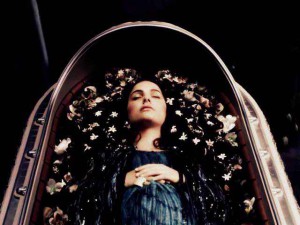
The story flows fluidly from beginning to end; from the opening battle sequence in the upper atmosphere of Coruscant, this movie wastes little time, diving straight into a roller-coaster ride that hardly lets up. That opening sequence, by the way, culminating in the decapitation of Count Dooku, is just brilliant, evoking the Original Trilogy while also expanding and raising the game.
The final downfall of Anakin Skywalker is superbly written and played out. Palpatine’s final, evil manipulations are a great, compelling and necessary element to the tragic story, while the film is peppered with so many sad or memorable moments and images that it’s difficult to even remember them all; Anakin being engulfed in flames on the lava plain, Obi-Wan’s heartbreak, the Jedi children hiding in the temple and mistakenly thinking Anakin has come to save them, the birth of Luke and Leia as Padme slips into death.
There are so many genuinely moving or unforgettable moments like that in this film and so many rich, extraordinary images that deeply embed themselves into the mind, literally all the way up to that breathtaking final shot of the familiar Tatooine sunset as Obi-Wan hands the baby Luke over to his new family. The image of Anakin choking the woman he loves is more upsetting than anything in the Original Trilogy and it’s at this point we know he is too far gone to be brought back.
It’s not all sadness though; there are plenty of pure bad-ass moments. Yoda decapitating the two Clone Troopers who come to execute him, for example. Or Mace Windu and co coming to arrest the Chancellor and the whole subsequent, tense fight for the fate of the galaxy. Or the Wookie army, which I almost forgot about!
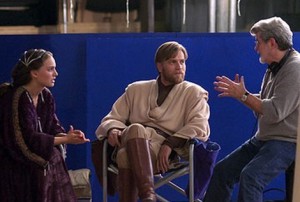
Amid the dozens of incredible, poignant images or moments, there are three particularly standout sequences. The climatic lightsaber duel between Anakin and Obi-Wan is just off-the-scale in terms of skill, choreography, drama, epic backdrop, and deep emotional undercurrent, all driven along by John Williams’ epic ‘Battle of the Heroes’ score, which really provides the finishing master-touch to the entire sequence.
This was a sequence we had been waiting to see for many, many years, and it thoroughly exceeded expectations.
Another piece of genius is the quiet, wordless scene with Anakin in the Jedi Council Chamber intercut with Padme in her apartment on the other side of the city, the two of them sensing each other through the Force as Anakin tries to work out what he needs to do next.
It’s a gorgeous, compelling moment, visually stunning, aided by some evocative music, and it is deeply mystical, probably deliberately echoing the Luke/Leia Force connection moment late in the Empire Strikes Back. This one, stunning scene, utterly devoid of dialogue, is more effective and resonant than any of the forced, badly written romance of Episode II and it demonstrates what a genius George Lucas can be – which makes the various misfires and misjudgments of Episodes I and II all the more frustrating, because we know George could do so much better.
The other particularly standout scene is the montage sequence of the various Jedi Knights being killed off in various, exotic locations, turned on by their own troops. Accompanied by John Williams’ extraordinarily evocative score, the extermination of the Jedi is genuinely so beautifully conveyed, as we watch with a sense of all the nobility and wisdom in the galaxy being coldly and methodically wiped out in one go. It’s really taking Star Wars to a whole new level; this film in general took Star Wars to a new level in its sheer scope and scale and its stunning levels of artistry.
Again, it’s the scale of the aristry and the vision that is so stunning; from the visual conceptions to the epic musical elements to the flowing tone-poetry and immaculate, Lucas-style transitions, establishing shots and juxtapositions.
This is arguably at its height in the operatic sequence that depicts the birth of Luke and Leia and the death of Padme, which is juxtaposed with the ‘birth of Vader’. It is an astonishing mix of cinema, visual art and opera; and – thematically – it retains an extraordinary element of mystery. We still don’t know how Padme died – I tend to favor the theory that her life force was being taken out of her by Darth Sidious and chanelled into keeping Vader alive.
Anyone who writes off Episode III – and there are plenty who do – is either in denial or just hasn’t taken in the film properly.
This is the film that is the final missing puzzle piece being put into place to truly complete the Star Wars mythology and to give the saga its truly epic scope. Anything that comes along now – including the new trilogy that began with The Force Awakens – is simply an expansion or continuation of a story that already has its original beginning and end.
As for what I think is the best of the movies, it’s difficult to choose between Sith and Empire and Jedi; but luckily I don’t need to – it’s all part of the same epic story.
Read more: ‘George Lucas is a Genius and REVENGE OF THE SITH is “the Greatest Work of Art” in 30 Years‘…
THE FORCE AWAKENS (2015)
–

The Good: Really good, flowing scripting; Daisy Ridely as Rey; John Boyega’s enthusiasm for being in this film; one last Han/Chewie adventure; some stunning cinematography; the ending.
The Not So Good: Snoke is a really lame MCU/Thanos knock-off; the Stormtroopers doing a Nazi salute – what the fuck was that about?; some excessive rehashing and lack of imagination; and, most of all, the fact that TFA rips the gut out of Return of the Jedi and deprives us of the happy ending we’d thought we had.
Best Moments: The Rey/Kylo duel in the forest (utterly gorgeous cinematography); the early Rey scenes on Jakku; the Death of Han Solo; Kylo’s communing with his dead grandfather’s burnt mask.
What works about TFA still works and what doesn’t still doesn’t; what was wonderful is still wonderful, and where it fell short it still falls short.
I don’t think we can properly judge TFA until this whole new trilogy has run its course. I still don’t see TFA as the absolute, glorious masterpiece that so many people seem to have thought it was; but nor do I share the somewhat baffling views of those who seem to despise it. There’s so much to like in this movie, so much that the filmmakers got right, that it is very difficult to hate: and yet every time I watch it I also perceive that there is something lacking in it, something missing.
And that something missing is probably the visionary spark and imagination of George Lucas. Conversely, what this also means that we don’t get any of the tonal misjudgements or scripting mishaps of Lucas either. So, apples and oranges.
In trying to get as far away from The Phantom Menace as possible, TFA manages to avoid any embarassments of the Jar Jar or Neimodian kind and there are no “yipee” moments. A side effect of this, however, is that it has almost nothing in it that is as jaw-dropping as some of the best parts of TPM.
Another is that it fails to present a coherent picture of the galaxy, the politics and the dynamics of this post-ROTJ era – which, ironically, is one thing Lucas didn’t fail to do in The Phantom Menace, but which lots of people subsequently complained about (as in, the “boring politics” of Episode I).
It is, in many ways, a lazy film that Disney played safe. Much of TFA is simply homage – and in some cases just lazy rehashing – of the Original Trilogy. At times, this works alright – at others, it feels lazy. The “here’s the original Death Star – and here’s the Starkiller base” scene is just about the worst culprit.
But, for all of that, TFA offers so much.
As far as TFA on its own merit is concerned (as in, not judging it against other Star Wars films), the script is still solid, the new characters are very well established, Rey/Daisy is a joy, and there are some genuinely great moments in TFA.
The Rey/Kylo lightsaber duel in the snowy forest is beautifully shot and nuanced, a really stunning piece of cinematography. The early Rey stuff on Jakku is generally superb – tonally, thematically and visually – playing like a silent movie or Lucas-style tone poem. Rey and Finn are a breath of fresh air. BB8 is genuinely the cutest thing in Star Wars since the Pit Droids from Episode I. Kylo Ren is a genuinely interesting, engaging new character, who is thematically interesting as an inversion of the classic Dark Side struggle.
And the death of Han Solo – which I hated the first time – is in fact a sublimely choreographed and rendered scene.
In fairness to TFA, I acknowledge that my real problem with the film is not so much the film itself at all (which I actually really like) – but is to do with the new trilogy’s existence and its effect on the previous two trilogies and the general soul or essence of Star Wars as a saga.

My biggest problem with TFA is that it potentially undermines and hurts what has gone before it: when you consider where Return of the Jedi ended and what the entire two previous trilogies were thematically and emotionally about.
The fact that Luke is now a failure, that Han and Leia never stayed together (and Han has simply reverted to the character he was before any of the events of the Original Trilogy), that the Republic never established a proper restoration, that the Empire is now more evil than it was even in the OT, that Stormtroopers now do Nazi salutes, and that the entire Dark Side corruption cycle is simply repeating itself all over again in the Skywalker family… it all makes TFA the most depressing of the Star Wars films.
Hell, even poor little Artoo Deetoo is so depressed that he puts himself into a coma.
ROTS might’ve been the most dark of the films – but the restoration of the light and the redemption motif was already encoded into that film (In the form of the Original Trilogy) from the outset. It was dark, but we all knew it ultimately had a ‘happy’ (ish) ending. With TFA, there’s just a sense of futility – that all the struggles and sacrifices of the previous six films (especially the OT) were essentially in-vein.
Again, I still ultimately won’t be able to judge how good TFA is in relation to other SW films until several years have passed and we can judge in full context.
And I still maintain that in some respects The Phantom Menace is a better Star Wars film (even if TFA is a better film in a more generic and contemporary sense); in other ways, TFA is clearly the better film. The difference is in scale, vision and imagination: TPM is just in a different league when it comes to imagination, artistry and vision, while TFA excels in all the areas where TPM failed – script, acting and pacing – but fails in the areas where TPM thrived.
On the balance, I still maintain that Return of the Jedi is the best possible end-point for the Star Wars saga (and that going beyond ROTJ chronologically – and ROTS in story terms – doesn’t help the overall Star Wars saga, but rather detracts from it): however, since it isn’t up to me whether Star Wars continues or not, I can celebrate The Force Awakens as a suitable, entertaining and – at times – endearing next step in that saga.
If I’ve sounded too harsh here towards this film, I apologise – I actually really like The Force Awakens. It is a wonderful film in lots of ways. And given the pressure on it and the enormous amount it had to do, it is essentially about as good a film as it could’ve been.
ROGUE ONE – A Star Wars Story (2016)

The Good: Superb, massive special effects sequences executed sublimely; much better world building and environments than in TFA; a winning demonstration of how new stories can be woven into the existing tapestry of Lucas’s saga.
The Not So Good: The characters didn’t necessarily come to life that well; the only moments that had any emotional punch were Vader and Leia at the end (about a minute-and-a-half of screen time).
Best Moments: THAT Darth Vader scene at the end; the Princess Leia ending; the epic, technically-brilliant Scarif battle sequence; the recreation of Peter Cushing as Tarkin.
A big part of what IS exciting in this movie is that it’s a first. It’s not only the first ‘anthology’ movie, but it’s also the first ‘concept movie’ in Star Wars. It is essentially a war movie, done entirely in the style of a war movie (with some of the cliches too), albeit one set in the Star Wars galaxy.
That in itself is, for now, a novelty and a fascinating concept. It was a risky experiment in some ways; and it both works in some places and falls short in others. But, overall – and given how badly it could’ve failed – Rogue One does very well for itself.
What really does win in Rogue One is its nature as a concept film: not just at the primary level of the premise. But in lots of specific additional ways too. There are lots of great concepts played out here – from the battle on the beach to the eerie restoration of Peter Cushing to on-screen life. There are also stunning visual moments and shot-composition, much of it during the Scarif battle, a lot of it also involving Death Star visuals. This is, visually, a great, great Star Wars film, and it is technically marvelous.
Although it doesn’t necessarily do very well with its main characters, it also contains two of the very finest moments in all of Star Wars: the Darth Vader rampage and the Princess Leia reveal. Both of these felt iconic – and pretty emotional – from the get-go, but what’s extraordinary is that they both occur together right at the very end of the film.
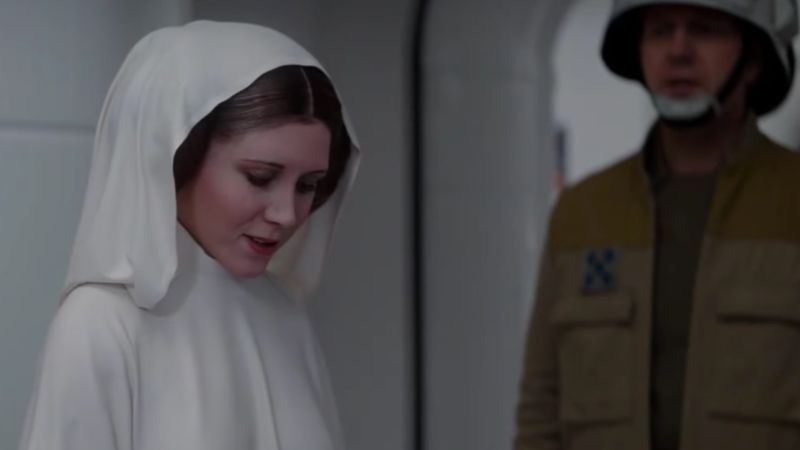
Rogue One does precisely what I thought an ‘anthology’ movie would and should do – it tells a story within the Star Wars framework, but doesn’t undermine or re-frame anything in the previous films. In fact, it enhances the previous films – both the prequels and, most of all, A New Hope.
I’m a bit nervous about future films in this category – and about Disney overdoing it and trying to milk too much from Star Wars too quickly. But if Rogue One is to be taken as a demonstration of how this is going to work and how well it can go, then it’s hard to resist too strongly.
And that about does it.
Lucas created the first Star Wars movie exactly 40 years ago. Four decades, a couple of generations, eight films and an era later, today sees the worldwide release of the next film in the saga. Whatever The Last Jedi turns out like, the one thing it will definitely be is interesting.
And the other certainty – as ever – is that it will inspire endless debate, disagreement, passion and analysis for years; just as every one of these films revisited here have done. People are still arguing about The Force Awakens and even The Phantom Menace or the Prequel Trilogy even now. If there’s one species that is forever in disagreement and always arguing, it’s Star Wars fans.
But, for all those heading into cinemas this weekend to see The Last Jedi, remember – it’s just a movie.
And for all those who were actually bothered to read all the way through this ridiculously long article to this end-point, we both know it’s not just a movie.
See all Star Wars posts here.
See all FILM posts here.
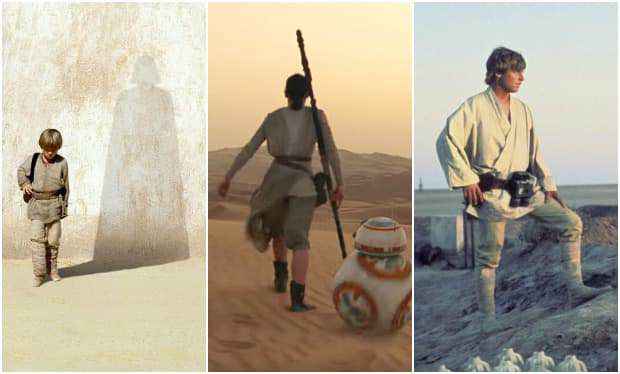
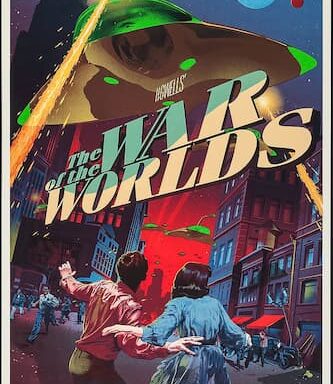

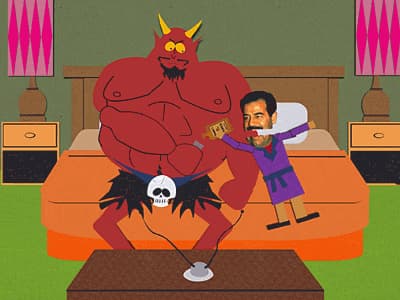
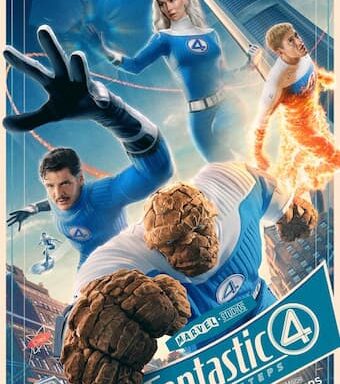
All together they were evaluated in the best and most ingenious way by you. Anybody else could not do it better than you, my earthling friend! After reading this article, I was happy like I ate ice cream with hazelnut, black mulberry, chocolate and lemon. Yes my favorite ice cream varieties are these,:) same as my favorite movie series like Star Wars! Thank you!
Thanks, my otherworldly friend. ‘hazelnut, black mulberry, chocolate and lemon’? Wow – this is the first time I’ve heard of that combination.
You need to try some day. 😉
Opened. Thx
Page Not OPEN G On 14 Dec 2017 20:34, “the burning blogger of bedlam” wrote:
> The Burning Blogger Of Bedlam posted: ” As Episode 8 of the Star Wars saga > hits cinemas and adds a new chapter in the mythology of the galaxy far, far > away, here’s a timely revisit to all the existing films in the epic, > magical universe Uncle George made. Even die-hard fans have mixed feelin” >